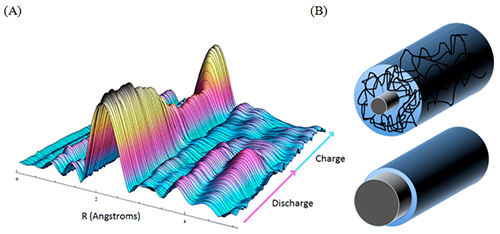X-RAY RUNS: Apply for Beamtime
2017 Nov 1 - Dec 21
2018 Feb 7 - Apr 3
2018 Proposal/BTR deadline: 12/1/17
2018 Apr 11 - Jun 4
2018 Proposal/BTR deadline: 2/1/18
Lithium-ion batteries (LIBs) can store energy from alternative intermittent sources via chemical reactions, for later use in electronics, transportation, and grid load leveling. Most commercial rechargeable batteries are based on lithium ion intercalation into layered metal oxides, the mechanism of which is fairly well understood. To move forward in the development of better electrode materials, deeper insights into heretofore unexplored methods of charge storage must be gained. Synchrotron-based techniques such as X-ray absorption spectroscopy (XAS) and X-ray diffraction (XRD) are invaluable tools to study molecules, materials, and systems relevant to electrochemical energy storage since they can provide structural and compositional information under realistic operating conditions (operando studies). A specially designed coin cell allows for the operando investigation of structural, compositional, and chemical changes within the battery as a function of the state of charge.
At Cornell University, researchers in the Abruña Electrochemistry Lab have explored the use of germanium nanowires grown in the Hanrath Energy Lab as anodes for LIBs. In a newly published article, lead author Katharine Silberstein (a CHESS-affiliated graduate student in Chemistry and Chemical Biology) and her collaborators studied the nanowires’ chemical structural transformations by XAS and XRD at CHESS in real time during battery cycling. It was discovered that lithiation occurs heterogeneously, preferentially into amorphous regions over crystalline domains, to the Ge4Li15 alloy phase. Those crystalline domains could be preserved for a few cycles if the voltage cutoff was above the point of full lithiation. This level of detailed understanding is critical to advance designs for next-generation anode materials.

Figures: (A) Fourier transform extended x-ray absorption fine structure (EXAFS) region at the Ge K-edge over the course of a full discharge/charge cycle of a germanium nanowire anode in a lithium-ion battery. (B) Schematic illustrating the lithiation mechanism of a germanium nanowire (bottom to top).
Details of this new research can be found in:
Katharine E. Silberstein, Michael A. Lowe, Benjamin Richards, Jie Gao, Tobias Hanrath, and Hector D. Abruna, “Operando X-ray Scattering and Spectroscopic Analysis of Germanium Nanowire Anodes in Lithium Ion Batteries”, Langmuir 31(6), 2028–2035 DOI:10.1021/la504382q (2015).
Submitted by:
Katharine Silberstein and Jacob Ruff, CHESS, Cornell University
03/20/2015
